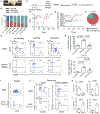Arthritis flares mediated by tissue-resident memory T cells in the joint
- PMID: 34706228
- PMCID: PMC8561718
- DOI: 10.1016/j.celrep.2021.109902
Arthritis flares mediated by tissue-resident memory T cells in the joint
Abstract
Rheumatoid arthritis is a systemic autoimmune disease, but disease flares typically affect only a subset of joints, distributed in a distinctive pattern for each patient. Pursuing this intriguing pattern, we show that arthritis recurrence is mediated by long-lived synovial resident memory T cells (TRM). In three murine models, CD8+ cells bearing TRM markers remain in previously inflamed joints during remission. These cells are bona fide TRM, exhibiting a failure to migrate between joints, preferential uptake of fatty acids, and long-term residency. Disease flares result from TRM activation by antigen, leading to CCL5-mediated recruitment of circulating effector cells. Correspondingly, TRM depletion ameliorates recurrence in a site-specific manner. Human rheumatoid arthritis joint tissues contain a comparable CD8+-predominant TRM population, which is most evident in late-stage leukocyte-poor synovium, exhibiting limited T cell receptor diversity and a pro-inflammatory transcriptomic signature. Together, these findings establish synovial TRM as a targetable mediator of disease chronicity in autoimmune arthritis.
Keywords: CCL5; CD8; IL-1 receptor antagonist; arthritis flares; cell recruitment; methylated bovine serum albumin; ovalbumin; resident memory T cells; rheumatoid arthritis; synovium.
Copyright © 2021 The Authors. Published by Elsevier Inc. All rights reserved.
Conflict of interest statement
Declaration of interests R.A.C. has a pending patent application describing depletion of T(RM) as a strategy to treat autoimmune and inflammatory diseases. The other authors declare no relevant competing interests.
Figures







Comment in
-
Erasing the memory of arthritis in joints.Nat Rev Rheumatol. 2022 Jan;18(1):5. doi: 10.1038/s41584-021-00730-y. Nat Rev Rheumatol. 2022. PMID: 34862493 No abstract available.
References
Publication types
MeSH terms
Grants and funding
- P30 AR069625/AR/NIAMS NIH HHS/United States
- KL2 TR002542/TR/NCATS NIH HHS/United States
- K08 NS112598/NS/NINDS NIH HHS/United States
- K12 HD052896/HD/NICHD NIH HHS/United States
- P30 AR070253/AR/NIAMS NIH HHS/United States
- R01 CA203721/CA/NCI NIH HHS/United States
- R21 AR076630/AR/NIAMS NIH HHS/United States
- R21 HL150575/HL/NHLBI NIH HHS/United States
- K08 AR077037/AR/NIAMS NIH HHS/United States
- R01 AR074797/AR/NIAMS NIH HHS/United States
- R01 AR075906/AR/NIAMS NIH HHS/United States
- R01 AI127654/AI/NIAID NIH HHS/United States
- K08 AR073339/AR/NIAMS NIH HHS/United States
- P50 HD105351/HD/NICHD NIH HHS/United States
- R01 AR073201/AR/NIAMS NIH HHS/United States
- R01 AR065538/AR/NIAMS NIH HHS/United States
- T32 AI007512/AI/NIAID NIH HHS/United States
LinkOut - more resources
Full Text Sources
Molecular Biology Databases
Research Materials

